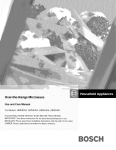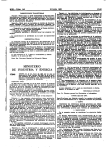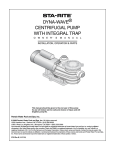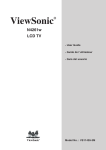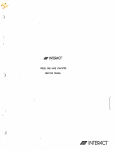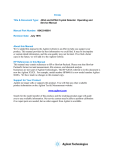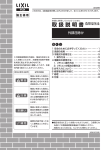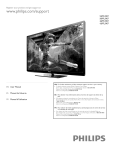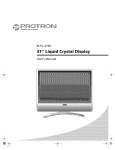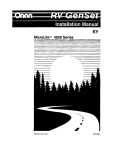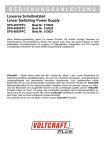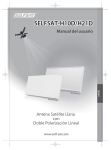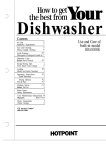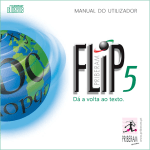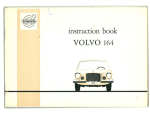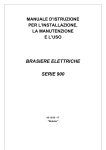Download AMERICAN BONANZA SOCIETY NEWSLETTER
Transcript
AMERICAN BONANZA SOCIETY NEWSLETTER
Editor: Ralph G. H.esloop
P\blisher: American Bonanza Society. Inc .
CHEMUNG COUNTY AIRPORT
Serving Elmira Area
HORSEHEADS, N.Y. 14845
Circulation : 5XlO
October 29, 1974
Volume 74, No. 10
Page 447
BONANZA OF THE MONTH
THIS IS MARY--copilot, navigator and
cowl cover seamstress extraordinaire.
Enjoying one's aircraft is the name of the game. Dr. Millard Harmon,
ABS #2633, 34 Elsmere Ave., Delmar, NY 12054, tells us how he has personalized
his Model 36, N77l0R, with numerous convenience and safety features. His interesting description of his various "Harmonizers" follows on the next page.
AMERICAN BONANZA SOCIETY NEWSlETTER is published monthly, "clpl for Ih' month of August.
Annu.1 memlMrship dun is $10.00 of whi ch $8.00 i, the sUbscription price to the Amerieln BOnlnza
Society N••• I,tt'r. Second CI". pos";_ plio.t Horsehuds, N.Y. '4845
Pa ge
448
Octobe r 29. 1974
NEWS AND VIEWS
BONANZA OF THE MONTH--CONTlNUED FROM PRONT PAGE
The ADS encourages aembera to forward articles and
photographs of their aircraft so that different idea. and
suggestions can be shared with other Bonanza pilots.
Dr. Hillard Harmon WTites ua 88 follows:
Dear RAlph:
1 would like to susgest N7710R 8. BONANZA OF THE
MONTH. The modifications involved do not rUD toward additional sophisticated equipment, but rather livins with the
aircraft until I have evolved those small items of peraonal preference that give an extra margin of sati.factlon
"'hen flyinS '
These peraonal preference items are a180 related to
safety and include:
1. Dual control waa arraDged when 1 bought the plane.
From past experience I've learned that it'. moat helpful
for 8 nonrated wife (who is an excellent navigator) to
hold the controls while I'm eating a sandwich. Hy wife
doesn't even drive a car. out of preference, and has even
less interest in flying a plane. However, through the
sandwich routine. I think she could handle an emergency if
I were incapacitated for any reason.
2. At six feet three inches, I always found Bonanza.
cramped for leg room. This problem was corrected, at the
time of purchase, by installing new seat raila with an
extra three inches of leg room (and appropriate notation
in log, approval of FAA, etc.) . This was for the left
front seat only, of course--my wife isn't six feet three
inches.
3. I flew the plane a year with the dual yoke in the
"up" vee position, but was unhappy with the instrument
viaibility--particularly the two VOR heads both of which
were on the bottom of the panel. Thus, I turned the yoke
around and have now flown the plane a year in the "dow"
position. This has proven unsatisfactory in cross-wind
landings, with my knees and the ram ' s horn colliding. So,
last month lance again reversed the yoke to the "up"
position, and moved the number one VOR head to just under
the "tach."
4 . After a couple of years of flying with a hand mike,
I had had enough experience with difficult flying aituations and the need to communica te, so decided a boom mike
was a aafety necessity. This was installed in parallel
with the hand mike so it could be used in an emergency.
This mike is also available for use with the ELT if 1 lose
my alternator--which 1 did one night ten minute s out of
New York City, but that's another s tory. I wa s unhappy
with the boom mike co rd catc hing on the fuel selector
switch and being under foot when 1 first climb in, ao I
rigged the wire (with dental floss) t o the first window
upholstery screw , over the compass light s witch, and used
the rear window upholstery screw with about six inches of
floss to maintain tension . The mike now hangs on the coat
hook just above and behind my left ear when not in use,
and the cockpit is clear of the wire. Also, the wire
doesn't get excessively worn. While the boom mike was
equipped with earphones, I disconnected them and prefer to
use the cabin speaker as a backup on communication. that
I may miss (copilots and passengers sometimes provi~e the
missing or garbled communi cation item) . A separate set 01
earphones are available for the youngsters to use with the
ADF without interfering with flying tasks.
5. I got tired of always pulling the check list card
out of the pocket and then dropping it on the floor or
getting it mixed up with maps, so I typed the check liat
(used five headings--BEFORE START, START . BEFORE rAKE-OFF,
BEFORE LANDING, AND SHUT-DOWN) , had them plastiCized, and
then scotch taped them to the control yoke.
6. Perhaps the most .atisfaction ha. come from my
developing what I call. "HARMONIZER COCKPIT ORGANIZER."
I've always been unhappy with maps, approach plate., notebook paper, and a number of other things flopping around
the cockpit . The leg strap with pad is uncomfortable and
spoils the pant crease j an open notebook crowds the cockpit, etc., etc. , etc. The "HARMONIZER" has a face plate
for paper to ca rry flight plan information as well as
record new frequencies from Center . new squawk numbers,
etc. Just under the face plate is a handy but separste
place for approach plates, and the compartment at the back
holds ay logbook and maps. (I'm presently researching
this project out to see if I could make this unit available
to fellow pilots, and if this works out, you 'll see my ad
in the Newsletter . ) Incidentally, the "HARMONIZER"
attaches to a special platform on the control wheel with
velcro.
7. Hy computer rose is attached by velcro to the
right aide of the control arm and is bearly visible just
under the left thumb rest of the copil ot ' s control wheel .
8. After three years of flying with a personal ELT,
I finally determined that the permanent location should
provide esay access in the event of exiting in the water.
Therefore, this is placed on the right side just behind
the door opening and is equipped with s third mike . The
advantage al.o of this location i. the availability of
this equipment in the event of an electricsl breakdown as
referred to in item four.
9. It also seems that the Kleenex was in the back
when needed up front in the pilot area. To solve this
problem, a plastic box with velcro was prepared and velcro
atrips attached to the upholstery just below the door
opening and to the right of the copilot seat.
10 . Special painted symbols have been placed just
below the pilot's window representing three significant
events in Civil Air Patrol service.
11. My talented daughters are preparing a nylon bird
cover (without metal fasteners) that will make use of
gum-taped hooks and ela.tic co rd.
12. One of my greatest pleasures is introducing
nephews, nieces. and children of our friends t o the glorious pleasures of flying an aircraft. While it may be
illegal (from the FAA viewpoint), a "copilot ticket" has
been printed to specialize these learning activities for
those for whom it is a first experience. A copy is
enclosed.
SO-enough of the "peraonal taate" business I
N7710R is a Beechcraft 36 , serial number E-I03, with
basic instruments and including. in addition, a Regency
Transponder, ADF. two Hark 12's with heads, a King 6OC. DHE,
marker beacons, strobe lights, wing leveler , EGT , Hobbs
Heter (tied to measure only gear-up time), large fuel
tanke, external power plug, SHARC-7 ELT (from ASS with
appropriate dollar savings), fire extinguisher. first aid
kit, flares, and six life jackets. (We fly over water
often snd always insist that they be put on when ove r
water. No problem now, but I can remember several years
ago when the younger of our five children strongly protested this mandate when we were 5,000 feet above Lake
Hichigan--in those earlier days 1 think they were wise
enough to understand the implication and we re not sure how
reliable that fan up there might be.)
October 29. 1974
NEWS AND VIEWS
Flying in heavy rain, sleet and tcing required that
the leading edges of the wings be stripped and repainted
a year or 80 ago.
This i, an absolute dream of an aircraft, and has
proven an excellent platform for CAP work. as well 8S a
great way to keep my five children acquainted with their
grandparents in Kansas and LaCrosse, Wisconsin.
Dr. Millard Harmon, ADS 12633
34 Elsmere Avenue
Delmar, NY 12054
1974 LOUISVILLE ASS CONVENTION HIGHLIGHTS
Have you noticed that each year we report that this
one is the biggest yet? Yes, it held true in 1974 at Bowman Field and the Galt 1Iouse, Louiaville, Kentucky. Over
400 Beech "birds" came in to roost bringing approximately
1,000 people to participate in the activities .
This is my fourth consecutive convention and it
turned out to be the smoothest yet . Arrivals were orderly,
parking was well-directed and handled in a professional
manner, cars picked up the arrivees at the flight line and
transported them to the terminal building where buses operated frequent service to the hotel facUity . Check-ins
were smooth and the registration desk performed at peak
efficiency. Ralph and Betty Haesloop are to be congratulated for their ability to organize and operate the conventions the way they do .
Robert L. Wick, Jr., M.D ., ABS 1687, of Ohio State
University, gave uS a good talk on stretchi ng the fuel we
use. He streased the importance of the right understanding and proper use of leaning procedures , more efficient
flight planning to eliminate time en route and ideas which
eliminate some of the things we do just because we learned
it that way. For example, many times it's cheaper (fuelwise) to go VFR than file IFR simply because the ATC sometimes sends us via the longer airway routes. Also, going
direct and VFR on top will save fuel whil e at the same
time staying tuned in with ARTC for effective communications and the good feeling of knowing someone Ls there
1f you want to converse with him (or her nowadays).
Dr . Wick also suggeated eliminating the ground run-up in
warmer weather prior to take-off if you have taxied far
eno ugh to get the heads warm and the oil temp off the peg.
The mags can be checked while taxiing and the prop can be
exercised at 1200 to 1300 rpm . Engine run-upa after a fuel
stop have alwsys been a waste of fuel snd time--not to mention soaking the engine and accessories with hea t when you
will be depending On them the most durin g take-off . Heat is
the great enemy of engLne health . His talk was not only
useful in helping to conserve fuel but it likewise keeps the
cost down since gas prices have gone up . My feeling was
that he was gently prodding us to think a bit more about all
these possibilities and in so doing we would be more effective in getting the best performance from our Bonanzas .
John A. "Sandy" Ooig, a pilot and CPA with Price
Waterhouse, gave U8 some tips on how t o save some tax money .
His talk covered many aspec ts of what to do and how t o do Lt
in relation to ownership of an airplane. However. each case
is so specLal that my understanding of his message was that
the best way to go about this is to use a good CPA who is
knowledgeable on the subject of aircraft ownership and
operation. Several of his examples were ~roof e nough that
a good professional doesn't cost money--he saves Lt for you .
Dick Scheff ner and Ken Gardner of Teledyne Continental
held sessions on the various Cont inental engi nes installed
in Bonanzas. This proves to be one of the important aeminars at each convention because Continental is able to keep
us abreast of conditions in the field of engine performance .
Many new owners are particularly pleased to attend these
sessions and learn more about the best ways to handle their
po....er plants.
J. N. "Norm" ColvLn of Beech Aircraft fielded dozens
of questions during the sessions he held. "Nann" is so well
versed on the Bonanza that it is truly a rare thing to s tump
him. Howev e r, if he can't answer a question, he wLll make
a note of it and write the answer to the questLoner after he
gets back "home" to Beech and digs Lt Out . "Norm" is a s1n-
Page 449
cere and friendly Lndividual and when he ge t s through answering your question, you have the feeling that he want s
you to get the best possible performance f rom your Bonanza.
AI itundere, PresLdent of AIcor Aviation held a sem Lnar:
on fuel e conomy and exhaust gas temperature (EGT). HLs
session waa truly one about not only getting the most out of
your fuel dollar but also how to be a....are of your engi ne ' s
performance and health. He paid the ASS a real fine compl iment by saying that his latest production item i s th e result
of feedback from Bonanza o.... ners in the ABS who have exchanged ideas among themselves in the newsletter and with
him on the aubject of cy linder head temperature (CHT) and
exhaust gas temperature (EGT) on all six cy lind ers . lie is
proud of hLs latest c restion which presents both CUT and EGT
simultaneously for any cylinder chose n by use of a selector
s .... itch. I have used this dual installation for over 500
hours and have stated several times that I feel that I have
the safety of a twin-engined aircraft (barring acts of God)
through the use of the in formatio n that CHT/EGT provides on
all six cy linders. AI explained how to use the EGT and he
presented all who stopped by his booth a copy of his latest
publication. "ECT AND OOMBUSTION ANALYSIS IN A NUTSHELL."
It's a 20-page booklet prLnted Ln color presentLng the
OIT/EGT story in a way that is easy to understand. If you
didn't get to the co nvention, or Lf you did and you failed
to receive a copy of this publication, r suggest you write
to AI at Alcor Aviation, tnc ., 5420 Bandera Road, P. O. Box
128299, San Antonio, Texas 78284, and ask him to se nd you a
copy . This knowledge, properly understood , can l ead to
airborne peace of mind when you are on tOp, at night, and
over the mountains .
The programs for: the ladLes were well attended and
many folks brought the kids, too, who seemed to enjoy themselves.
Hr. Leddy L. Creever , Vice~President , and Mr. tlarry
Cregory, Manager Customer Service of Beech Air c raft, were
Ln attendance at our daily sessions a nd banquets.
It never fails to amaze me the way our members dLg
in at these seminars. The attendance is always heavy and
the Lnterest deep . Ou r speakers Lnvariably comment that
they never experienced such intensLty of interest and depth
of questLonLng as they find at an ADS conventLon.
This report o nly sc r atches the surface . If you have
not been fortUnate e nough to attend the conve ntLon, you are
miss Lng out on the Lnformation program of the year as it
pertains to how and why Ln r e lation to your Bonanza plus
missing the opportunity to meet the grea t es t members of any
organization in aviation. Hope to see you next year !
Paul R. Morton, ABS #749
244 Cardinal La ne
Delray Beach, FL 33444
LEAD NOSE WEICHT IN S-35 & LATER MODELS
Dear Norm :
In a recent article on turbocharged Bonanzas (ABS Newsletter page 424), Dr . Sommer mentions a 48 · pound lead weight
beLng remov ed from t he nose of his S-35 . It has been called
to my attention th at this fLgure can hardly be a cc urate.
Could you inform us as to the correct weLght of this lead
block and o n whLch models it .... as used? Are there any other
occasions when it can be removed?
Ralph G. Haes loo p, AS S IllS
Executive Director
Dear Mr . Haesloop:
This is in reply to your lette r of July 29, 1974, in
.... hich you refer to a lead weight located in the nose bug of
the Bonanza series S-35 through current produc tion. The
standard weight con figur at ion weighs 20 pounds and canno t
l egal ly be removed unless by STC whi ch then alters the aL rplane from th e original configura t ion .
In a very few cases at customer r equest , heavier
weights have been added to offset unusual loadi ng condi tions
but thLs Ls rare and the weight did not exceed 41 pounds.
The Hodel 36 Bona nza does not use this weight bec ause
the wLng spar was moved 10 Lnches aft so the weLght Ls not
needed.
J . N. ColvLn
Project Service Engineer
Beech Airc raft Corp.
Page 450
October 29. 1974
NEWS AND VIEWS
TIPS ON FUEL CELL REMOVAL AND REPLACEMENT
Dear Ralph,
I truly envy those members possessing a vast
intimate knowledge of their planes and make every effort
to work alongside the mechanica to learn how parts fit together, how systems work. and fail and why. These men
have been patient. helpful and glad to explain their work
to one who is genuinely interested.
A recent sickening experience occurred upon enter~
ing my hangar to find fuel spilling from a leaking fuel
tank. The first chore after turning the fuel selector
to "Cff ll and pouring fuel into car. cans. and a garbage
can was to go through all the ABS newsletters for advice
on how to remove the fuel cell . The scarcity of information there and in the service manual prompts this letter.
with my observations, of how knowledgeable professionals
removed, repaired, and replaced the unbaffled cell from
the left wing of my V-35A, and my own suggestions, as not
all aechanics have had an opportunity on a Bonanza, and
there's no need to learn at our expense.
1. Carefully sc rat ch the paint away from the edges
and centers of all screws in the two access panels on the
top of the wing around the fill spout and near the wing
root. A few minutes here will save you hours of drilling
out those @'$%~& . ? Phillips screws that have had s ix years
to set up~ A t ouch of Liquid Wrench on each and time to
soak can be a big help . Remove the outboard access hat ch
on the underside behind the pitot tube and the cover by
the jack point at fuselage. A very useful tool is a brace
and bit t ype socket wrench with a couple of different
aized Phillips points; and use Iota £f pressure and ~ alow
start when starting those screws . Hake sure the point is
tiie"tight alze.
2. Pour safetied fittings must be removed, two of
which ara fuel gauge. which at first try seem too lar8e to
withdraw, but they will with careful manipulation. Note
orientation before removal. A sheet metal support bracket
slightly larger than the inboard access hole must be removed from there--outboard forward corner first. A similar bracket in the outboard hole also comes out.
3. Two vent lines must be released at the fitting
behind the pitot tube, using a hose clamp plier . Removal
of the rubber tank nipple from the aluminum vent line
should not be attempted until the Liquid Wrench has had
time to loosen the bond between them. Be careful. not to
manipulate the rubber nipple as these break off easily,
and ~ repair agencies w11l .!!£!. attempt to repair ~
Goodyear tank with damaged nipples . They sometimes can
be repaired at a savings of hundreds of dollars, however,
but only if you can find a repairman that will take the
time. Reconnecting these vents can be difficult.
4. The quick drain comes out when unclamped--again ,
reluctantly, so try to lub e it first. This i s another
nippl e to the cell and is easIly damaged. O-rings cos t
$1.30 each, one of aviation's greatest rip-offs, but now
is the time to repla ce them if needed. Wher. reinstalling,
a clamp tightened with a screwdriver rather than the bolt
type may be easier.
5. The fuel feed is unfastened with two 11/16 inch
wrenches, duckbill pliers and an icepick. (This was where
my tank let go , at the nipple-to-tank joint.) Be especially careful not to lose parts into the fuselage.
6. Sixteen snaps hold the tank in place to the top
of the wing. On reinstallation, note their locations and
spacing and keep count as you snap them in. A touch of
lube helps.
1. Carefully pull the cell out through the inboard
hole and try not to introduce new c rea ses .
8. At this point, good professional tank inspec tion
and repair 1s needed. I wa s fortunate to encounter Mr.
Dutch Loehr, presently in Kiami at (305) 887-6902, though
he expects to retire to a semiact1ve status after many
years and thousands of tanK and deicer repairs.
Apparently Uniroyal make s a tank superior to Goodyear, though both brands may be found in the same plane .
The longevity of the tank is largely determined by the
habit of keeping it topped off to prevent drying out of
the rubber, as desc ribed in the owner's manual. Leaks
usually oecur at nipples, corners, edges, over th~ landing
gear bolt guard, and in the upper portion of tanks not kept
full . Cracks in the outside plastic coating of the cell
are relatively unimportant 8S it is the interior rubber
fa ce that does the sealing, and this must be perfect. A
professional can decide if a tsnk can be expected to last
if repaired , as handling of a marginal cell during repair
can create more leaks than practical to repair. If a patch
or new nippl e is required, two types of adhes ive ca n be
used . Mr . Loehr uses chemically activated cements that
give a much stronger connection than contact cements ,
though it takes about J 1/2 days to complete the Job due
to long waiting periods while the activators are drying
before 8ea11ng. He built three nipples for me that were
superior to the original installation . They were made
from fabric-reinforced rubber tubing and special cemented
fabric shaped to form the mushroom. Old nipples were
carefully measured, ground out, tank hole edges chamfered,
presealed, new nipples installed, resealed, and pressure
tested.
9. Before reinstalling the cell , the interior aluminum wing skin ahould be wiped with ordinary oil to prevent
corrosion as the shoc k of cold gas in a hot wing in the s un
will cause qu1te a lot of condensation within the wing that
can only be eliminated by slow breathing of the wing.
Talcum powder should not be used as it will simply form a
moisture-retaining sludge, and moisture is an e nemy of
aluminum. Oil the inside of all nipples before hooking up.
Vacuum the inaide of the tank, hook up the gauges and
verify fuel readings. lubricate the four gaskets with
either zinc chromate paste or Tite-Seal, and replace the
aafecied fieeing8. Recheck ehae the gaa cap aeill fica
tishtly or you ' ll be streaming gas when you flight test.
(See Norm Colvin's excellent letter in 1/29/72 ABS.)
10 . Always be especially careful not to twist or
bend rubber fittings unnecessarily. Most of the problems
will involve screw removal. fitting disconnects and reconnects. It took two of us 2 1/2 hours to remove and it
would have been half that time except for painted-up
screws with damaged edges. The repair portion cos t me $90,
quite a lot lesa than the price of a new tank, which was
the alternative when told by another outfit that nipples
could not be repaired. 1 expect the repaired ce ll to last
at least three more years.
If there are technical errors or omiss iona in this
report, which is intended to be of benefit to those who
have never seen this operation performed, I ask your
forgiveness.
Alan L. Fitzgerald, ABS ~5493
1771 S. E. 10th Street
Ft . Lauderdale, FL 33310
FLYING IN ENCLAND AND PORTUCAL
Centlemen:
Please find enclosed a cheque for dues. t have
recently bought a villa in Portugal, so have cha nged for
a B-95. Having t9 cross the Bay of Biscay and the
Pyrenees every time, it feels safer with 2 engines. But
gasoline 1s $2.40 a gallon in Portugal . Duty Free is
available only at the Porte of Lisbon and there is a
$25 c ustoms attendance fee. It makes me cry. Went
down in a bad one a couple of weeks ago, after taking a
rough time for an hour at 7,000: finally went out ove r
the water and came down underneath. Came out at 350 feet
and had 2 1/2 hours like that in really heavy rain.
Here in Blackpool we have the Air Touring Club which
is a bunch of private owners with 3 Bonanzas, 1 Debonair.
I Travelair and 1 Baron. If if goes on, we will be 100%
Beech.
Harold Southern, ASS 13515
45 Oldfield Ca rr Lane
Poulton Le Fylde
Blackpool,
Lancs, United Kingdom
"
October 29. 1974
Page 451
NEWS AND VIEWS
WINCHING BONANZAS
Bonanzas get heavier with age (mine).
Here l s a picture of a simple installation of a boat
winch mounted on a bra cket weld e d to t.he back wall of our
T hangal:.
When we
years ago, it
has a locking
place to lock
downhill.
bought the winch at a surplus store some ten
cost. five dollars complete with cable. It
ratchet and dog which can be flipped into
the winch and prevent the load from slipping
We maneuver the Bonanza by hand until it is more or
less lined uP. then run back to the winch and crank it into
the hangar. We have an asphalt paved floor and paved ramp .
If one doesn't have a helper to steer the nosewheel.
one must. take care that the tail is tracking into the T
straight. One may have to run back and adjust the nose-
wheel until the plane is moving in a straight line into the
hangar. Usually it will enter the hangar with only one or
two adjustments if it is lined up to sta rt.
CORRECTION OF MISSTATEMENTS REGARDIN G FUEL VALVES AN D
UPLOCK ROLLER FITTINGS
Dear Ralph :
On June 20, 1973 . we wrote a l e tter to you regardi ng
lubrication of the fuel selector val ves for Bonan zas (see
ASS Newsletter page 369).
We have had an occasion to review this information
and have found two errors . We s tated that fuel selec t o r
valves from the Model 35 through the G-35 are cone s ha ped
in design; this should include the 35 through the H-35 .
We al so state d that the valve was electrofilm coated for
lubricant purposes. This special lubricant coating wa s
not used on the early valves but became available on spares
starting in 1958 and after.
During this year ' s Bonanza Society Convention. I mentioned the availabil ity of a flush t ype grease fittin g fo r
uplock roller bolts on Bonanzas and Barons. Hare r ec ent
information has determined that the flush grease fittin g i s
not r equi r ed on Bonanzas and applies only to recent production Barons wh ich incorporate a newly designed landing gea r
down l ock so Bonanza and Baron owners need not be con ce rned
with th e need for this change since the change was made
only on Barons with the redesigned down lock system.
Beech Aircraft Corporati on
J. N. Colvin
Pro jec t Service En ginee r
.
WII,..,.,,1JC'1lOM
OM ~A4f J '''IYI''.)
>T~.
-~
"~
_ <M"
"'-".
,
~
; ;;... ,;~.
""'''"
. . .. ... , - .. . ,""
._.- ..
-;..;..
If the plane is more than ten feet out from the
hangar entry , with the cable attached to the tie-down ring ,
hang something conspicuous on the cable to prevent someone
trying to drive behind the plane while you are getting set
to operate the winch.
We experience considerable floor heaving from frost ,
making it almost impossible to hand push the Bonanza over
the aill and back into the hangar in winter .
Be sure and disconnect the cab l e after winching in .
If a slack cable is left hooked to the tail, next time you
pull the plane out over the sill. the locked winch and
hooked cable will stop the plane with a jerk that might do
damage to the fuselage.
A. F. Edwards . Jr., ABS 14866
17901 East Warren Avenue
Detroit. HI
48224
IF YOU THINK YOU'RE HEAVILY TAXED
One of our ABS charter members. Vincent F. Garofalo.
M.D •• ABS '730, P. O. Box 33, Kabul , Afghanist;n, is an
Italian medical doctor working in Afghanistan for the
World Health Organization, a function of the United
Nations. Vince owna an A-35 Bonanza of Italian registry
(see ABS Bonanza of the Month, Nov . 29, 1972, page 279).
In a recent letter. he has reported as follows a new
Italian government tax on General Aviation aircraft:
"1 had some troubles with my Alpha Victor . 1 was
obliged to pay to the Italian Government a tax (they call
i t "una tan tum") which 1s new for private planes and has
been issued because of the Italian bankrupt economy--just
a little extortion of 1,500 bucks !!! I figure that only
5 Hp more on my engine cost me $750 extra. In fact, it
was $750 up to 180 Hp and $1,500 up to 250 Hp. I believe
that if this economic crisis progresses any more, General
Aviation is destined to succumb .
Vincent F. Garofalo, H.D ., ABS '730
P. O. Box 33
Kabul, Afghanistan
.., •.
"
~
.., ,. ,. ,_
..
.
11 _ _ 11--.. _ _ ... _
....
--;:
.. · _ _ .... _ .. _ _ _ ·_ ......' 11 _
~
---_
...... _----_ .. _----_._-_
--'----,:;-.
.. .... .. c. _ _ .. _ _ ..... _ _ _ _ _ _ .. _ _ _ _ _ ...... .... _
- - _ .. _ _ _ _ 10_ ... _ _ -
"l7.~_
_- ..-
.-
--,
-"-
::..::=!:'::':"-"":":.-::-.~"': a:::",,:!:, D ~--...
I... ~~-".-,
~
I·
I.
,..,
,
....
....
......
-;- ,
,
I·
'.
I-
, ~-
~---
~
,..,
,,'"
...
ii
....
'"-"'-"
. _..........
"'"
'"
'912
~:;.~;:.
-.,
""
~
"'"
·k~~'
...
. ~;r..
u
October 29. 1974
452
Page
NEWS AND VIEWS
.us
elln I
REGIONAL CHAPTER NEWS
NORTH CENTRAL CHAPTER--Need an excuse to fly sou th
this winter to get warm? Well, now you ' ve Bot one. Your
chapter and the Southeast Chap ter are planning a j01D~
fly-in at Marco Island, Florida. January 17 through the
SERVICE INSTRUCTIONS
19. Those are f1rm dates 80 you can IJIark it on yn'lr
calendar 8S the weekend for your "Fun in the Sun."
as, a . a , II. "
For more details , contact John Frank, Jr., 2800 S. Cl ement
to, lI • •
. 10, 10, 10,
• 200
Ave . • Milwaukee, Wis consin 5320-7-.-- -
EUClIIICAL nllO.. UCltT'
STIIO.UCIITS
SOUTHEASTERN CHAPTER--Reserve the dates of January
17-19. 19 75, on your schedule for a spec tacular weekend on
Florida' , Gulf Coast . It is on thoae dates that the
Southeastern and No rth Central Chapters are sponsoring a
joint fly-1n at Marco Island, Florida .
. .......
The airport there
14.)..1 8e«h. Amdt. 38. 1177. A~ to
Modfl F33A ( Sttbl Nurnt.t-. CE-43IIlbni
C£..483 n«pt C£.G and CE..t82): Modd
\1358 (SerUoI Nm",-" D.94oeO Ihru D·1l538
eacrpll»48l. J).Q'W • ..d D-9t533}, Model
A38 (sm.1 Nllm,-" E.4Z.'I.hru &.47lS 0cept £-431 )1 MIII'~h 9lI·1lM • •111 Q5.1\M ....
(SHiro! Numwn TCI552 ,hru TC· IOOT
except TC-IMT, TCI5.58, TC IM Ind
TeIOO4 h Mph Fm: lind E.'IaA ( smal
N,,~ TeDI" ,hru TCIIotO
TC1119, n ·1O! .",1 ""~D l, aflll Mndorl, .~
"'.... Il8A (5I!r1roJ Numbwi TII-325 thru
""""'pi
TII0383
H~
TII.J.18. TII.:JJ1. nl.a113
ancI m al airp.1M!S.
-
~,
fk<qund .. Indlclt!!d. 11ft.... u-ty _ "'IliUIotCI f"""" ~h
Servn Imtnod" - 01111--.... (II "I", FAA-
.........
To clIedt '-ndift......h<ld< ot .... "". ....
for proper h..tI_. wlthl .. ,he. """I 100
houn' IbM 1ft ...-ke .'er lhot dfedl""l doole
01 tAil AD, _ _ PlW! IhII fono...tna.
_
Al
UsinS I por1able lwd_
tester.
1M Iwtl_ 01 the _
IJIW Wd:
IfnII pbtOll In III . . . from 1 hoeh to " Incheol
wheel fork, The allow.ble
hartlt.. ...... It! from 1\od!:_11 Sc:Uo C38
.bo¥e the _
toC4e I/ 2.
_"-I5J.,..' .." A..... 1'[ U........ J'[I':-
U'''UlA. _~'''''''''1'£M I.
• . . J.IA. _1lIJtJ ........ 1lI.j(1O.
DItIIo 'WO ....... _ ' I U ......... ' ·: .
o.-" fIO._Ll-JS .
lJI..oIM
O' .. ('IIO,_U-'Ol ....... U ....
-._LO-MI .......
UO. _ lW I """""" lw Ill,
' " _ _ _ U-I'l .......... U.!4tI .
~AIo IOO ... A.OO . ...... W I - . . . t-:'III.
...""tU.,. .....
I ....... . . JO
_-
T._ ....
..........._ .. ,,_ ..., _ .......
.....
Ao_._·_",", ""... ",_ .......
--......
-
Ifd""",,lhII~_·
rt.dlnl
Ipp""
wwdlable.
fAA
-
_ __
T."'_
J _ ..... _
, . ... _
~-
k_
............
JJ.)UUUI.
""'''''00
J _ ..... _
.-
.....
--.
...
.... -...
...
rern.lm ,!own 1",1 """'.....
effeetl.... febnt-
--- .. -•.
T."'_
,
le"'_
1!_............... ,.... (Il10. ., . . . . . . _ , _,'
I I• ..,. _ -..,. .. I.""'"
IlIICtIn.o\FT . ......, _ . _ ......
.. _ _ _ " O - W..-QO C'"
......1__ .. -.
r\fIUCA.,..1IYKnD:
(804) 737-0550.
The person to be contacted is Mr. Robert Jenkins ,
President.
Since the manufacture of this uni t was discontinued
in 1956 , Flight Research has maintained an FAA Repair
Station for the aervice to the APC a8 well a, a spa re parts
inventory . Due to the Lncrease in demand for our other products, it has become inc reasingly difficult to service the
control unita within a ahort period of time.
We feel confident that Aladden Electronics, Inc.
will be able to continue to assist all Bonanza owners requiring assiatance regarding their Automatic Propeller
Controls. They are also an FAA Licensed Repair Station
for this instrument.
We sincerely appreciate the contacts we have had over
the years with all Beech Dealers and Bonanza owners .
William J. Waymack, Plant Mgr.
Fl i ght Research , Inc.
Richmond, VA 23201
..
- -- --.
.........
..
_--....... 1-_-
01
APC PROGRAM FOR 8EECH ELECTRIC PROP SOLD BY FLIGHT RESEARCH .
THE ORIGINAL DEVELOPERS AND MANUFACTURERS
Dear Hr, Haesloop:
On September I, 1974, Flight Research sold the Automatic Propeller Cont rol Program complete to Aladden Electronics, Inc., Box 203A, Route #1, Sandston, VA 23150,
1'lICI.
1. ... _
T."'_
""'100_
-"J_
, to_
....
Mln*-" .
'* -""""
~
QU.umn'
1_,"""
JJ,JU6,nJl.
"lOM.!III.
...
Ml21 012U1
additional ~. II other IIJIOI. 1M
within the I Inch to • Inda ... ~5ed
herein ""If! III! _ _
1:1
I",('..d,,~
.y 5,1914..
....•..
JIIJnc",J4J
Sal'"
Ih.. ~ .",.". ....,nfko! In
II ...... / .... ft ~ IhI~ All. ""'" 1<1 f"It"'" ft\Pt.
" ·1....... an .. 1...,...."1ve ..... Ii..1 ~ •• ..Md.tnlt
..... 011 ",.,h I" ;o.1_ h y ,-,.011. r .arpt thai
lho: IIrpIanr m;oy he now. III ~ wid!
FAI!. 21. 197 101 I baJIl",t.c:~ 1M ~
C'J.II bol perfnrmed. pnwIdeIl ' M 1&r.... 1ns . .
'"::!:. . ~ --- - ..- ..... ,..
"""""'"
'AIITIfUM.1I
,hot .de ~.... "",. .lIn.... ble hud·
''''''' r. n,. u from ~_II
C43 1/ 1 to
c;o 1/ 2. If durlntt ,he ""~ -.urine
PfOOe" II rndl~ IJIP"tI Ullftilablo., make
_IfL_ .'.,...pI.
."It'"
,_C-"'N .....', ..........,.......
...
~::c=;J,::'...
Ul lng a Im.ble hlrd!'lell tuter,
the' hlr(' ~ 01 bot h m.IIln llear thodI
li nd piJ'''''1 '" In 11K 1 Inch to • I,,~h...
C) If . hanl",," ..
_~
DIM fi .
""' ........ ..-.- ........... _...,.
0)
.....III'd,
......
A".-
1-.1 ........ ,'-".......
_01_1_,
TTII'3~"re
II,,~
1_ _ .., ......, _ ....... ,
-..-
.,.
111ned.
n..,
;roo._ ..
,......',t1l~W
A ...... _
Iro~ ~ •
",,,
VUI ...... 0 . - ........ 0._,
.0.»_[..02<1 ........ '."., .
.........
make addllioul _wanmb.t other IpIItI
but ",llhIn the I Inch 10 • Inch ...a Ip«fIl!!d
hem .. unlll a.. IM.'l'Uf1Itt' meuuremml It! ob-
ow
. f.CHCkAn _ . UJA _CIt<lJlo .......... C'E,:O
IE£Ot
v...... ,
IMJoIC n u l"!I
tM._I_'_
....................
....,. ... ,__
,.. ,
...................
___
", ___ ,", "'C'_'f"I
_I'
.., ..,..
is 1 mile southwest of the c 1ty and has a 4,OOO-foot
paved runway , 15/33 . Hake sure you 're there to meet the
migration from th e North. For further details, con tact
David Barton. P. O. Box 80649 , Atlanta, GA 30341.
EDITOR ' S NOTE ON HARCO ISLAND HEETING : The participating
chapters have aaked us to note that all Society membera
are invited to the fly-in at Marco Island, Florida.
Contact the Southeastern or North Central chapter head for
more details.
--
IHlI1ALLA l IOti 01' _
I"ICTI\IITY:
~-'_
-
I'._doOI._ .. ,.,_I..__ .... O.,'.".r ... _ ....
....... . " . . _
,,,,,,,,"-l,'-IioifII'
-
....... <-"' .. ,....._ ............
--"' ......
100 ... ..... . .' 1 _ ...........
-*~
.......... .---......
.........
-"..
.......
.,. n.,.
...........
"'-_
I
'.01 .11 1M
.. 0<ttI.. _
~" ...
~
... _ _ . . . . .
.......... ,. . . ....
_.t.HI,...._
. 0ntI_ '."., . . ___ ...... _
....., ......
~
_ _ It'OJH"... ll t "'.... .,.
._ .... .......,. ............. --." ,... oN'"
....
I I~
....... _
........ - , . . - ....
, c_ ,... _._ .... _..- ....... .......
........, '. ,... _H"
_ , . . . . . ",. . . . . . ~ II • • , . _ , ... ",....... '
booo:ko1 ...... _
...it
MSJJJOII..J.J ,,_. A1'I<IIIOOIL "'_, ..... "" l iOULa
.,"
u,.. ......._
_
--.-,
_. ...-.. ...-
lot _ _ ..., _ . ... ~ Gr-. ,,,. _ "
.......,. .... ,.... r._"..- .. ,........
I "-1100 _ _
. . "' ..... ..
...,.-~-......,.
of , .....
., --..
_,
'0. ,••
",........ '
...
.....
K,., Alf
._. ..,.-..._..,._
.. -...-'-.....
-...
.. __.. .,. .....,.
... --. ..,.1IIO,"'.t..,
,- ....
-...,....f.... ....
s ....
1.'11U._
_ _ . . .!'OO....,.
. . . . . . . __ _
......
.....
....... -.f•• ' ' ' _ ........ of . .
....
_,of,
:00,~
... ............ - . . _ _ ..... _ _ _
....... '10
.- .....' ...-,.
_
... _I . ... ..........
!'OO_
.... lU ll:.,.
.. " .. A" _ _ _ , .,.
""! IOO ' to. _, I_ lito 10 _ " ' _ (.., _ .....
MlU*:...J ....... A~IIIl. ........... 1I51100 IU
!. ~
............
_ .. ,... _1·, ",,"'" ""'. __
~_
-,,",,~,-
'o t'Ioo<k'...." .........'.,.".... f... ,..,.'.,.'•• _
50_. ""'__.-. .. _ ....... __._....
Page 453
October 29. 1974
NEWS ANO VIEWS
!«)RE ABOUT on AND YOUR AIRCRAFT ENGINE cont ' d fro. Sept.
form its function efficiently. Of course, there is GO r e to
In the previous article , we lis ted the two basIc types
an oil sys tea than thi s brief description. But for the
of oil used in general aviation aircraft piston engines as
operator who need not be a mechanic, this basic information
can be helpful .
straight mineral and ashless dispersant (AD). We also
The oil comoaniea tell us the basics abo ut their prodstressed the importance of clean oil in achieving SOOd enuc t. Viscosity of 011 is resistance to flow. An oil which
gine life , and oil consumption 88 an indication of engi ne
flows slowly has s high viscosity. If 011 flows freely.it
health waa another important item discussed .
Continuing our consideration of the oil and your airhas a low viscosity. Unfortunately, viscosity of 011 is
craft engine , the primary purpose of a lubricant i . to
af fec ted by high or low tempera tures . At below freezing
reduce friction between noving parts. Another additio nal
temperatures, some high viscosity oils b~come virtually
reeponsibiUty of t he oil is to help cool the engine. As
SOlid, whi ch makes circulation and lubrication impossible.
it circulate. through the engine , the oil absorbs heat from
But no matter what visco s ity oil is use d, when the outside
the parts . Pistons and cylinder walls are especially depend- temperature Is 10· F or lower. preheat of the Lycoming enent on the oil for cooling. In addition to reducing fric gine must be accomplished befo r e attempting to a t art the
tion, the oil acts as a cushion between metal parts. The
engine , or damage to the powerplant wil l result . Avco
011 also aids in forming a seal between the piston and the
Ly coming does not approve the use of 0 11 dilution for cold
cylinder wall to prevent leakage of gases from the combusweather operation of ita e ngines . It is extremel y important
tion chamber. · Oils help reduce wear by picking up fo reign
that only oil in the grade recommended by Lycoming be used.
particl •• and carrying them to a filter where the y are
To Simplify the sel ection of o11s , they are classified
re1llOved .
unde r an SAE (Society of Automotive Engineers) systeDB.
U.lng a direct drive, wet sump powerplant as an example , which divides all oils into groups as follows:
we can aimply describe the lubrica tion sys tem of these l ess
Comme rcial
Commercial
Army & Navy
coaplex aircraft engines. A more detailed description may
Aviation No.
SAE No.
Spe~. No.
be found in the Overhaul Manual or the Engine Operator's
e
m
~S
Manual . In a wet sump engine, the oil is contained in the
80
40
1080
engine s umP. a8 opposed to a dry sump powerplant wh ere the
100
50
1100
oil i a in an external oil tank lo cated perhaps in the wheel
If you are looking for a can of 30 weight aviation 011
well or the rear of the aircraft engi ne nacelle. In a dry
and i t has the nWlDe r 65 on it. t hen it is 30 and also 1065
sump engLne. the oil is drawn froa the oil tank by the pres- under the Army & Navy Spec . If it has a more complete
aure aect ion of the oil pump throughout the engine. and then designation with the letter "w" added , then 30W indicates
returned to the oil tank by the scavenge section 0 f th e 011
the viscosity (grad e) of oil ; it does not indicate quality
pump. The other basic parts of the oil system are very
or other essential charac t eristics . But any FAA approved
similar to t hose used in t he direc t drive , we t sump poweraviation oil on th e market today does a good job--and withplants.
out us ing any addi tive s by th e owners in t he field.
In the wet aump engine, the 011 pUDIp draws oil f rom the
Before we conclud e our discussion, we want to remi nd
rear of the sump through the suc tiOn screen. and sends i t to our read er s of a coupl e of miscellaneous but important rethe oil press ure Bcreen. A by- pass valve in some models is
lated items, On multiengine sircraft each engine ia
loca ted between the press ure side of the 011 s ump and the
su pplied with 011 from its own compl e t e and independent
oil screen. It permits unfiltered oil to bypass the sc reen
sys t em. Another reminder--every engine has a brea t her which
and enter the engine when the oil filter is clogged , or dur- can be cons idered a part of the oil system . If that engine
ing a eold start . The spring l oading on the bypass valve
does not hav e s pecial provisions for aerobatic fl ight and is
allows the valve to open before t he oil pressure collapses
flown inverted. th e oil will be lost out the breather and a
the ac reen. or in the case of cold congealed oil, it prose rious engine failure can result. We definitely recommend
vides a low-resistance path around the sc reen. It is felt
that engin es not built for aerobatic flight should not be
thst dirty 011 in an engine is better ths n no lubrication
flown inverted .
at all. Hoat oil systems offer as optional or standard, a
I n summing up this brief supplement consideration of
thermostatic by-pasa valve in the same l ocation which a l so
011 and your engine, it was not intended as instruction as
contain. a pressur e relief feature to by-pass the cooler in
de t ailed for the knowledge r equired to be a mechanic . But
caae it 1s clogged. As the name i1Dpl1es, this unit reguwe t hink you will agree that the typical pilot should know
lates the temperature of the oil by ei ther runnin g it through mo re about his aircrsft engine than Hr. Typical Driver knows
the oil cooler if it exceeds a preaet teaperature. or byab out his automobile engine--the penallY for not knowing the
passing the oil cooler if the oil temperature is l ower than
bas i c i s greater in aviation.
the thetllrJatatic by-pass setting .
--Cou rt esy of The AVCO LYCOMING FLYER
Continuing its trsvel. the oil next encounters a pres sure relief val ve . The latter regulates the engine oil
pressure by allOwing excessive oil to return t o the s ump.
The oil continues to travel through drilled passagewsys
AD S has checked on the progress of the petition
throughout the system and finally r eturns by gravity to the
to amend FAR Sec tions 61.25 and 91. 21. An FAA project
011 s ump where it brings the journey allove r again.
unager. Hr. Frank~, has been ass~gned and he is
Thus the principal unit s in the typical wet sump engines currently researching the project snd answering many of
are--s sump of sufficient size to contain the necessa ry
the letters and inquiries from ADS members and their
amount of oil, an engine oil pump, oil cooler and by-pss s
congressmen . The responae from the membe r s hip has been
valve, pressure screen and by pass valve , pressure r egulating terrific. However. it i8 now probabl y beat if we reserve
valve, oil pressure and temperature instruments i n the cock- our strength until the project reaches the Notice of Propit, an oil su.p drain. a fUler neck to put 011 in the
posed Rule...king stage. Coaaent s to the FAA at that time
engine, a dipstick to ..asure the aaount of oil , and a sucwill be most effective.
tion oil screen. The full flow oil filter is optional on
For those who are perhaps waiting to take IFR inthe four- cylinder powerplants, but recommended fo r high er
struc tion or a flight tes t, it appears that a change in
powered engines.
the PARs normally takes a considerable length of time
We need acreens and filters in the 011 system to keep
going through the required FAA of tices . So please don't
the oU clean 88 it cir culates through the engine sa blood
hold bsck anticipating an early change i n the regulations.
does through the human body . If either are contaadna t ed ,
Our whole-hea rted thanks go t o our many members who
they carry that contamination as they circulate. We also
hsve supported this project. We'll try to keep everyone
need an oil cooler for most engines so thst the oil t empe ra- po s ted ss new developments occur.
ture may be kept within presc ribed limits and able to per-
Page 454
October 29, 1974
NEWS AND VIEWS
BEECH COMMENTS ON RECENT SERVICE INSTRUCTION AND SAFETY
COMMUNIQUE
C~eedJ.aaft
Dear Ralph,
Enclosed are two items that 1l1ght be of interest to
Sop...... 10. ,,,,
ASS members.
Service Instruction 0663-600 reminds owners that
maintenance of the owner's airc raft is the responsibility
of the owner . However, in all fairness to the airplane
owner, he ha s to rely on his service facility or mechanic
to comply with the overhaul periods or lubrication periods.
If the maintenance facility or mechanic does not have
the Beech manuals, chances are parts do not receive overhaul or proper lubrication at the prescribed periods or
never, for that matter. Fortunately, components in Bonanzas are tough, 80 will tolerate considerable mistreatment.
In mos t cases , lubricant of items s uch as flap actuators or
the landing gear gearbox require attention at 1000 to 2000
hour periods. Items such as elec tric motors may require
attention at more !requent intervals. What this amounts to
is that it is a good policy to ask the service facility or
mechanic if r equired service periods have been adhered to
during periodic inspections .
A second item is our new safety communique. This
copy announces a new and improved fuel selector valve handle for Bonanzas from the Hodel C35 through the Model H35.
This is an attractive handle that allows good leverage to
turn the selector valve. Beech will offer this new handle
at an attractive price. Parts are not yet available,
however, so as soon as they are available we will issue a
Service Instruction and send you a copy.
J. N. Colvin
Project Service Engr.
Beech Aircraft Corp.
SAFETY TIP CORNER--BROKEN ELECTRIC PRIMER FUEL LINE CAN
CAUSE A FORCED LANDING
Dear Hr. Haesloop :
It 1s extremely important thst owners of Bonanzas with
"E" series engines equipped with electric primer solenoid
inspect or r eplace the metal line which runs from the carburetor to the electric primer solenoid . Ours broke and
caused a sudden depletion of our r emaining f uel and a forced
landing which resulted in a broken bird. The solenoid i s
hung from the i ntake manifold near the carbur e tor and i s
connected by a metal fuel line. I n some cases , this can
cause a vibration which will fract ure or break this line.
I recommend replacing it with an approved rubber f uel line
of the s ame I. D.
Rober t G. Riggs, ABS '7061
The James Dryer Co.
Military Road
Lexington. KY 40504
Dear Kr. Haesl oop:
This is in response to your letter of September 18,
1974, regarding me tal primer lines.
Metal lines have been used for some time to carry
fluids and vapors in aircraft systems . When installed in
accordance with FAR 23 and when they are maintained per
Chapter 10 and Chapter 14, Section 2 of AC 43.13-1, metal
tubing can be and is satisfactorily used in the various
sys tems. The tube materials used in the system are to meet
the specifications set forth in FAR 37.
The use of 37 degree flared tubing secured with
AN 818 B nuts and AN 819 sleeves has replaced the older
practice of using beaded tubing, hose and hose clamps in
systems which direc t fluids and vapors under pressure .
Flexible t ype hose is required in applications when movement between two units is involved, such a8 fire wall to
engine and/or brake lines between landing gear upper shock
strut and l ower piston assembly.
Whether or not metal lines should have ever been
used requires consideration for circumstances at that time,
such as pas t performance. cost, weight, material availability and ease of field maintenance. With consideration
for FAR's and good or preventative maintenance in service,
the use of metal tubing in this location wa s sa tisfac tory.
L. H. Aldrich
Service Engr.
Beech Aircraft Corp .
Executive: Airplane Safety Communique:
AI 0..... of IEfCHCItAI'T ......... 05 . 035. EJS. F15 . en lind Hn. _<lOb 1).2'J01
I~ D-5ll0, ..... pt I).S06l. lind _
of ...16t1 ......... willi l ~ No l~S16S ...
To,
J).'~"""'plllOllIl.d.
AI lEEC1tC1lAI'T AolaI .... c.n l.". API'f'I'"'I SIopport C•• lon, Aoro CIII"" lind
loiOraOtlcNl .,..,....... oM Do~
Jl&IICf' f\/£L SI!L£CTOIt VALVE IIAlIOLll
"liNk ..,.""'01_.0.00 ..........
tUct; ......
Wk:01t ....... ,... ............... Iho JS.I)2' 2JO I... _, ~ ..... - 1000 .... -...I. .......... , II willi'" fIMly .. 111l1000 •• ',..nc.d 01
05111rou&h H1S ........ I).2901 dII""IIo D-51JO,
r..... ba ..... _ ........ [).I "'-" [).:!900.
_ _• TWo _ _ _ &.:101)'
."aIIooII ............
"""'pi D-*2."~'" lito ...lloblo IIIIt11 No.15.H~S
For "'"" o«Ioion, optfl,b! • ..-I)' .......... '-<lit "- """ ~ 10 ptOriiir .. lmpt<Io'tII hoM
........ oM ........ ~ ..... """' ... ""blllI' n.. _ ~ ..... , p&ft 1WDbo, " ·'1oI1IH , .. ~ p&ft
....... l).tl4lSl . ...... _ _ ... 1M f .., OO)' ~ ...... tad .. KI. Mo. JH7fi I
-.
IOoII_........
n. _ _ .... ,wtoidIoIo FAAA"..,... ...........
poaolU'OO_. fot
.......... _,.....wodIlIo ......... _ _ wIIftUOlIo .... ...,..tI ........ ..........
. . . y .... _ pi-. ~..wI lot ...................... willi _ , ""'*>01\ ...... oM S--
M.....,... _ ...................... "'fIIIIo· ..........
1)
.. r....
..uon. ..u.... tholtloelot ...... _ ' "
""I... ~ 'o
2)
....... lbOItho.Itc'''' ....... f_,
_ " " .....' . . tIoohMllof........... ~'"
.,. I\IWII dItdt, IM f_ ,.....",., 1M. ..." . duo .... tdoc' OI
. .k ""t.obofT.
"".'01 II. pOOI1""," ' 0 . pn>ptr
Do .......... 01 . . . . . . . . . . . . . 1*1' .......,. wtII 1M ..,...-. 10 So ..... ,......... -
No.06»m ....... I10 ...... _
.
No._
eo. ,,'0
ATA
IUlJUT:
" 1SCE1J.ANEOUlI • TI .. !! UlIlITS . o asu,vole IN"fTI"L TI ME BETfI1':EN
OVERHAUL
Itff(cnVlTY,
111 .... 501'1 ,
AI BEECttCIIAI'T '.pI_lft ........
TO ............... of OIIhor_ 10 h .... bo,,,,"," _rILoool '''I......... r.. tho
pot ...., ,....1<.;... ",,0c0I .. , _ ,.... ocM\tuIft ",d .Imo tlnUu '''1 .... _
..
Tho FtdmI " .. , .... II . . . " .... pIKlr tho
roo '''' _ ... _. 01 1"""
owo,.."'
..,.,-, ... _ ..... ,... ....... _ ..
,..-IIohI,-.I.............. trr .....r..a
~f""'"
..............r"'_'W\lIoollolr_...... fflqU._ .............
cmwtJANCI!.
""JOIM-••
Opor.,... .._ ....
.......11 Slqr,' M""'lftr.......... u... """ NoI',
NIfIIIted ""'_, MIll
td><dulo.
"'1rtrhrItr ....... u... od•••M ••
... Ii... Ianj" .... , ...... <............ lot fir ..
''''1 U tho
",.." .. Iw an _ _
"".m ho "lOr ,rdu<c .. nl'rroI ""hoilu'" b"",,, 0/1
A, .otroI '" ... _
"pUc""""
d.""'"01....
",,,,,,,,,loot
1'"""'" .. ,....-mI ......
.. po .......
_....
ct.ck II.. _,II... """ .. pI~ ... rtI ICho,"'" r.. ,ho 1n!wrI ''''1 ... 011 h_ IM'_~
_",.., Chock 1"'0""" ",ltotrIirIo , - . - ' _ . _.... ,ood , _ Mor.... _..,no ..
Al'PIlOYAL:
"ANPO'I'O ,
"ATEAl.tL,
WAIIlIIIANTY,
Sl't:CIAL TOO,""
fAA~
....
....
....
....
....
....
,._e4
Tho
ocACE·:
_,,,",,1 . . . .pIoc ......, -.IrcOo1t ..... _
S""""M_ ......... 101_............. _ _ of .......
01 .. ,....,._., .......
""'"
'.0,..,' .. .._oil
_Iiort, of
1l>t II", _mOlt'
1<1 bo ""fo' .... 4 "",1... , th .. tM toq~I .. 4 I"""'"
Tht
11M lI.m " ,ho ..... ." ,b<
I"'""d con b< "'" •• e,;"n. rOf
dttHmin" ..1Iooq.... , po,1od> oppIkablo to ,lit ... dI .... ~'" ",mit '" r.... opttt'lotI
"",",,III lilt opt ..... "'" III .",.......d -"tor.... .,......
,ondl'.... .,..
.......
---,
n"t
.
Tltot .... porlodsIOf ...,..,,_oornl iII'ho .......
~-
rIO
b....,j"" ...' ....... """
SPlCIAL CONOIfKY.'iSCAUTIO'IAIiV NOlK't:
fOl fW t ..I . """, 'Nn rronnoI optto'lOOI """ ."pI... OfI<,.,nI ..
IumrocIltopicsDf<OldI .... d.... d .... '... fI< . ....,IOtt4_frfl!lOHll ....
.... , oonor6on ."",... 1Kt of Ioobri<.,..... '" lhnr .... I"'nodl< ftItt< ...... rhould lit
l'I'r.......d "",u'''-opt..
'~
po,Iod> ~-.J ~" .. pont ....
Allmon
"",,'e4
""'·'_r...
'01 ...... .. 0..... ,.""",\0>11
_,n-....... ,...
lIM roqroIn'd po"-'" IlOl COIItI,t~~ ....., .., .. ''''' It... "'D~ .. h
lilt ptriocI wI.hooo!
oror. __ ,-.! r",on ' ..Il0l
_ a.,teIH ~
~'
'N .......'K...
IlfCORO ro!oI'LIANCIL
.....
'- -.










